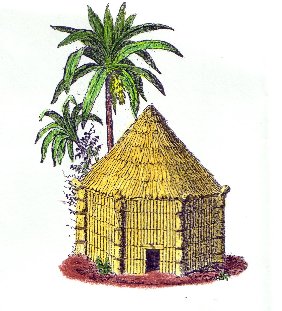 The tainos not tenian history written, but the town taino tenia and toward its history, and the trasmitia of generacion in generacion in a different way to it written: by tradicion oral. To traves of the areytos (songs acompanados of dances).
The tainos not tenian history written, but the town taino tenia and toward its history, and the trasmitia of generacion in generacion in a different way to it written: by tradicion oral. To traves of the areytos (songs acompanados of dances). The history of the Caribe indigena is mended to some 6.000 go us before ours was (A.C.).Desde then they began to populate the islands of the Antillas by communities gentilicias (nucleos family primaries), organized comunalmente in bands. Some three or four centuries before our tiempo(A.C.),las Antillas experienced the development to an upper level of organizacion in tribes, or asociacion greater of communities of clanes. The tribes learned to cultivate the ground and vivian in semi-sedentary villages.
During various centuries, entering our era(D.C.) and approximately to the 400, the archaic communities were mixed with dominant groups of filiacion linguistica aruaca (the arahuacos, as tambien is known them), whose presence in Puerto Rico is identified with an indicador arqueologico: the ceramica called "Saladoide", of the place Salader, near the desembocadura of the Rio Orinoco, of origin ancestral Venezuelan.
Petroglifos tainos
The tribes of the tainos, whose formacion is detected for the registration arqueologico as of the 450 to 600, they are the expresion of the resurgimiento of a town autoctono. The vision of the world taino was ordered by a type beliefs system teocratico and that they symbolize the cemis of different representations (strengths of the nature deified), such as Yucahi, God of the agriculture; Marohi, God of the Moon; Juracon, God of the storms,...
"You FEAR"
 THE TAINOS: A town that wine of far away.
THE TAINOS: A town that wine of far away.YUCAYEQUES.
CACIQUE TOWN.
THE TAINOS, a town of firm beliefs.
THE GREAT INHERITANCE TAINA.
THE TAINOS: A town that wine of far away
Before living in Borinquen, the tainos they inhabited in America south, in the ground that today they form Venezuela and Guyanas.Built large canoes, using trunks of arboles.many arrived at the Antillas smaller and many remained but there was who habian oido of an island with beautiful forests and then they arrived at our island. Al to arrive they found another people living in the island and was a town called IndianThe but old.be a town pescador and itself establecian in the coasts. By this razon the tainos they were found it pequenas villages. The tainos, established in the island that they called Borinquen..
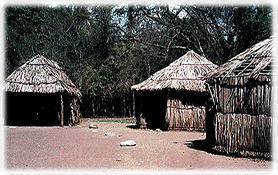
YUCAYEQUES
The ground fertiles of Borinquen were the best gift than they found the tainos. Their communities were established near the rios, asi as in the flat valleys where sows is it the but ventajosas. This name perhaps derived from its main cultivation, the yuca.all the yucayeques they were organized around a central patio or batey.be the center of reunion give them indi�genas, where they celebrated large events, all helped to maintain it clean and pretty. Al front was found the casadel chief of the yucayeque called caney. Of rectangular form the dwelling was considered but important, the remainder of the houses or bohios was situated alradedor of the batey and its form was circulate.all the yucayeques teni�they go a part of its ground dedicated for it sows exclusively and it was called conuco.this was the prte but important of the town taino because its main one ocupacion was the agriculture. On the other hand the yucayeque was the place where they were placed the deperdicios. By being consumers, the indigenas, tenian objects and things that rejected, as eranlos bones of animals, helmet of jueyes, seashells and other. Quizas not seem so important but for the arqueologos (cientificos that they study the origin of the man) if it is.al to find these scavengers located the place of the yucayeques.with the step of the time, all the island was populated for the taius, establishing yucayeques for all the Island and these they were remembered for the names of the caciques in which we mention the following.
BACK
CACIQUE TOWN.
Agueybana Guanica.
Coabey Jayuya.
Cayeco Cayey.
Macao Humacao.
Majagua Bayamon.
Orocobix Orocobis.
Caguax Caguas.
Mabo Guaynabo.
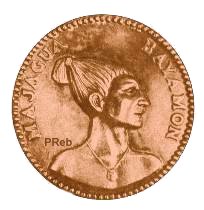
Territory that occupies the present municipality of Bayamon formed part of some of the yucayeques tainos of the island of Boriquen..
Although not it know themselves the numero of Indians that they inhabited the region their poblacion however not debio to be very high. The yucayeques they were always written down near the river currents. The Indian taiwere us araucos that procedian of America south. They were men and women of pequena stature, of skin bronceada, almond-shaped eyes, pomulos outstanding and black hair..
In each yucayeque existia a cacique that was the authority maxima of the region. At the same time these caciques, although autonomos in its yucayeques rendian obedience to a cacique maximo called Agueybana..
The society taina was divided into three main social groups: the caciques and nitaynos (elderly and warlike); the bohiques (priests) and the naborias, that they formed the mayoria of the poblacion and the pyramidal base of the society.(1) The name of Bayamon, although its true origin does not know himself, is possible that fuese the name of a cacique that has not been able to be determined. The Dr. Cayetano I Strain and Toste considers to Bayamon as the seat of the cacique Majagua. Segun the mentioned historian in 1510, "the conuco of 8,000 piles of yuca and boniato of the Cacique Majagua is sold in almoneda publishes for Juan Ponce of Leon: a Hundred pesos to Juan Ceron, to Frameworks of Andon and Garci Troche, to attend to the expenses of the incipient colony of Borinquen"..
(2) The writer bayamones D. Walter Murray Chiesa is the person that but he has studied the figure of the Cacique Majagua and his greater one promotor. (3) At present there is a school in Bayamon that carries the name of Cacique Majagua..
BACK
The Tainos, a town of firm beliefs
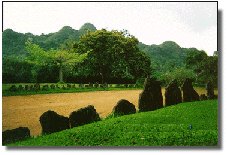 A carasteristicas of the tainos is their religiosidad, its God as the sun, the wind and the rain represent the strengths of the their main God was Yocaho, protective God that vivia in the turey, or the heaven.other God of smaller to be able called cemies, warlike or caciques themselves convertithey go in cemies al die.the cemies themselves it pedian proteccion for the yucayeques and they were espiritus good, builtstone, algodon and in the inbterior the bones of large warriors were placed or caciques.the God maligno were juracen represantaba al God of the winds of the ciclon, that traito large lost al yucayeque.they creithey go that the God were fed the same as they, ofrecian ofrendas, food as fruits or casabe.the bohique and the caciques they spoke with the God, these they consulted in a special ceremony in theirTobacco.the illness was for the God bad.as it bohiques conocigo the powers of the plants, they used these to cure illnesses. Among these they used the aname, the sabila, the tua-tua and the higuereta.the taius creian in the life despues of the death.when a member of the yucayeque fallecito, they placed vasijas with water and food in its tomb, al to die a cacique tenito a rectangular, special burial, walls with branches, was placed in its dujo and in posicion fetal. Its favorite wife was buried living together with the, in her honor..
A carasteristicas of the tainos is their religiosidad, its God as the sun, the wind and the rain represent the strengths of the their main God was Yocaho, protective God that vivia in the turey, or the heaven.other God of smaller to be able called cemies, warlike or caciques themselves convertithey go in cemies al die.the cemies themselves it pedian proteccion for the yucayeques and they were espiritus good, builtstone, algodon and in the inbterior the bones of large warriors were placed or caciques.the God maligno were juracen represantaba al God of the winds of the ciclon, that traito large lost al yucayeque.they creithey go that the God were fed the same as they, ofrecian ofrendas, food as fruits or casabe.the bohique and the caciques they spoke with the God, these they consulted in a special ceremony in theirTobacco.the illness was for the God bad.as it bohiques conocigo the powers of the plants, they used these to cure illnesses. Among these they used the aname, the sabila, the tua-tua and the higuereta.the taius creian in the life despues of the death.when a member of the yucayeque fallecito, they placed vasijas with water and food in its tomb, al to die a cacique tenito a rectangular, special burial, walls with branches, was placed in its dujo and in posicion fetal. Its favorite wife was buried living together with the, in her honor..THE GREAT INHERITANCE TAINA
The Tainos not they disappeared, they left us tantas things, their presence follows living in our island.there is many words in our language that inherit as, hammock, macana, canoe, guiro, macana and other.there are hundreds of fruits, flowers and arboles that they conserve their name tainot as, papaya, the ceiba and the ausubo a large quantity of rios and towns carry names tainos as Bayamon, Humacao, Guayama, Utuado, Vieques and many but. Our fruits or alimentacion conserves customs tainas com the arepas, the casabe and the guanimes..
"You FEAR".
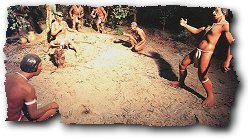
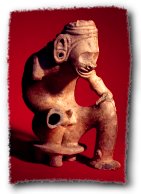
The organizacion social taina
THE DIVERSIONS TAINAS
THE I BEAT, a special play
The organizacion social taina
The tainos was a town organized and dividian the tasks, activities and you owe among the people of the yucayeque. THE CACIQUE lider and chief prncipal of the populated. The took the decisions, already they went upon the government, the life or crrencias.it crrespondia to protect al populated in case of war, organized the defense of the yucayeque.Cacique that signifies 'THE ONE THAT DIRECTS AL TOWN", by its posicion tenia the best house of the yucayeque, used a throne or special seat, that itself conocia as dujo.the guani�n, hung ofIt was named succeeding al son varon of its older sister, was buried with its wife preferred, with weapons, food since its belief in the life despues of the death but of that we will speak then. NITAINOS: SPECIAL ASSISTANTS; A grpo of distinguished men, or special assistants of yucayeque.Servian al cacique in different tasks as reparticion of food or the distribucion of the job and servian as warriors when was necessary to defend the yucayeque. BOHIQUE: lider religious; responsible priest trasmitir the beliefs, servia of teacher for the youths.be who ensenaba the history of the town, tambien it correspondia to watch for the celebrations of the parties and ceremonies in honor to the God and in moments of emergency advised al cacique.another of its tasks was of medico or faith healer of yucayeque. The bohique used songs and plants to move away "the espiritus of the illness". Juntos, the cacique, the nitainos and the bohique, they formed the government of the yucayeque. THE NABORIAS; was the group but large giving it society taina.be formed by all the families that vivian in the yucayeque.the naborias obedecian al cacique and they helped to that its yucayeque was the best.
BACK
Not all it was job, tambien there were moments that they were dedicated to the diversion, for such razon, tenithey go that to plan and to prepare all the food and the beverages.during the parties nobody worked, alone they enjoyed themselves. The areyto was the party that celebrated the taius when habia an ocacion special; a wedding, a good crop, the victory of a war, the appointment of a cacique, they were ocaciones to celebrate an areyto. The batey especially was fixed, in that great plaza of the yucayeque, during the parties the cacique invited to the Indians of the yucayeques neighboring. These customs permiti�or that be to established loops and friendship and will among the towns Indian.the own cacique initiated the activity, intoning songs spoke upon the hitoria of the yucayeque, all the town it esuchaba with great atencion. These canticos trasmitian the historaias among the tainos. It remembers that the taius not they knew the scripture neither they had books.in the areyto, the Indians they danced al compas of the musica and the song.the dancers seguian the rhythm, while repetithey go what they sung the cacique or the bohithat. They danced individually or they were taken for the arms forming rows and asi danzaban during hours or lasted but of an I gave, among women and men. The musica was interpreted with diverse instruments.used the guiro, the maraca, the drum and a species of whistle, with caracoles or fluta done in wood since the guiro and the maraca done with fruits of plants.the drums were done of trunks of arboles ahuecados or of helmets of tortuga .
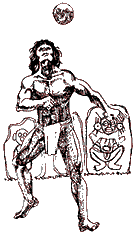 THE I BEAT, a special play
THE I BEAT, a special playThe tainos they enjoyed another special event, the play of ball or beat.is of religious meaning, Asia of diversion.celebrated in the batey, this of rectangular form, done floor of clay apisonado, as compact as the cement. It was bordeado with large stones that tenian beautiful petroglifos or drawings of stones that represented the images of some of its cemiis. The ball that was used was prepared with raices, herbs and rubber.the tainos it mexclaban all, boiling it until forming a paste, then it was given form. Asi, obtenithey go a heavy ball but that rebotaba with facility al throwing it. For the play two equipment with 23 players were needed each one. According to the rules, not itself podia to give to the ball with the hands, alone itself permitia�to use the head, the knees, the elbows or the hips. When was going to begin the play, the assistants sited down around the court. The special guests, asi as the cacique and their assistants, they occupied their dujos. To initiate the play the equipment were placed to the sides of the court, then, one of the players threw the ball al equipment contrary.if to one itself it caia the ball and rebotaba, podia to follow playing on the other hand, if the ball itself caia� without rebotar, a lack to that equipment was noted, the less lack had that gained.
BACK
The sculpture among the Indian Ta�nos of the Antillas Greater
Al to commemorate the Fifth Centennial one of the Discovery of America by the Spaniards, we have to remember that they went the Indian ta�nos of the Bahamas and the Antillas Greater the first men of the New World in enter contact with the Europeans. It went in the Antillas where the Spaniards forged their conception of the aboriginal one American and they discovered plants that to would should to contribute to transform the agricultural economy of the Old World and to enrich the farmacopea of the epoch. The use by the Europeans of the tobacco and of the rubber, as well as that of the hammock or hanging bed, that very prompt would be adopted to the facilities of the European navigation, were also turned out of the trascendental encounter. And, it was, finally, adopting words ta�nos that initiated the Spaniard the process of enriquecimiento linguistic that there would be of being prolonged in its subsequent contact with other American tongues .
The encounter among Spaniards and native went also decisive for the society ta�na that, very prompt, before the impact of the conquest and its consequences, disintegrated entities that to have finished the century XVI. The society ta�na that in the Antillas Greater and the Bahamas they found the conquering Spaniards was the result of old migraciones of Indian aruacos that did more than thousand five hundred years, since the regions of the noreste of the America south -what today we know like Venezuela-Guyana- they had arrived at the Antillas Smaller and, since these to the Greater. For the century X of ours was they had achieved a florecimiento cultural thanks al development of an economy based on the cultivation of the yuca and the corn. Since Puerto Rico (Borinquen) that was their oriental border, they defended the Indian ta�nos their hegemony in the Antillas Greater facing the invasion of the Indian caribes, that since the coasts suramericanas they had invaded the Antillas Smaller and, already having conquered the Virgin Islands, since there they carried out incursiones to attack and saquear the Antillas Greater and the Bahamas.
The center of the culture ta�na was found, al moment of the European conquest in Puerto Rico, almost all the Spaniard, especially the region orients and in the extreme this of Cuba. Great part of Cuba, Jamaica and the Bahamas were marginal areas. BACK
 For this date the society ta�na had reached their full one apogeo that was manifested is their magical-religious and political institutions, as they were the cacicazgo, the cemi�smo, the existence of complex ceremonial centers, the play with ball of rubber and the ritual of the cojoba, by means of which they communicateed with their God and spirits tutelares.
To this political complex of institutions, with its society jerarquizada and the magical-religious beliefs that governed its life, the rise of a rich artistic expression owed itself whose main demonstration was the art escult�rico .
For this date the society ta�na had reached their full one apogeo that was manifested is their magical-religious and political institutions, as they were the cacicazgo, the cemi�smo, the existence of complex ceremonial centers, the play with ball of rubber and the ritual of the cojoba, by means of which they communicateed with their God and spirits tutelares.
To this political complex of institutions, with its society jerarquizada and the magical-religious beliefs that governed its life, the rise of a rich artistic expression owed itself whose main demonstration was the art escult�rico .The art in the Antillas is not initiated, however, with the ta�nos. Indian archaic, recolectores and hunters that populated some of the islands does more than seven thousand years already tallaban ceremonial objects of stone and wood and did paintings rupestres in which its artistic aptitudes were manifested. A short time before of it Was Christian already the Antillas Smaller and Puerto Rico they had been populated for Indian saladoides or inger�a, originating from the America south. The saladoides they produced the most most beautiful ceramics of the Antillas, from time to time policromada, as well as delicate corporal decorations tallados in stone and in other materials. The art of the Indian ta�nos as that of all the aboriginal towns reflects its private conception of the world. The ta�nos they believed in upper spirits that they controlled, to times capriciously, the human nature and the world. To these spirits the man should flatter, to appease or to neutralize through rites and sacred ceremonies. The art ta�no, incarnation of said beliefs, he was expressed, with relative or absolute technical control in pleasant elaborate, conventional forms with the most most diverse materials. Of some of their copies, executed with matter perecedera, only the description he reduces us that of them the columnists of Indias they left us .
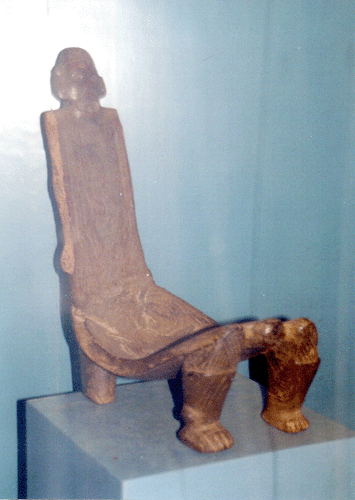 Few artistic objects of value were saved from the systematic destruction, carried out by the missionaries and colonizers, of everything that for them, had magical-religious meaning, that is to say the idols and other ceremonial objects of use. Of the destruction, that obeyed to the religious ideas of the epoch, only they were saved those that they were sent, as exotic objects, to European princes renacentistas who conserved them in their cabinets of curiosities, and those that, on time, they achieved to hide the Indians in caves and other inaccessible places for the conquerors, and that they would be, centuries later, re-discovered by arque�logos and rural.
The archaeological investigations also there are redescubierto other objects that already had been rejected pursuit the ta�nos centuries before the conquest. They should recognize the work of those coleccionistas of the century XIX and first decades of the present one, that in the Antillas, without being arque�logos the majority of them, they were dedicated to collect and to gather the objects of ours Indian, that accidentally they appeared during the works agr�colas or the construction of roads or buildings. These valuable objects some of which are insuperables exponents of the aboriginal art, not they had arrived to us if to not have been by the dedication of these coleccionistas or studious antillanos .
Few artistic objects of value were saved from the systematic destruction, carried out by the missionaries and colonizers, of everything that for them, had magical-religious meaning, that is to say the idols and other ceremonial objects of use. Of the destruction, that obeyed to the religious ideas of the epoch, only they were saved those that they were sent, as exotic objects, to European princes renacentistas who conserved them in their cabinets of curiosities, and those that, on time, they achieved to hide the Indians in caves and other inaccessible places for the conquerors, and that they would be, centuries later, re-discovered by arque�logos and rural.
The archaeological investigations also there are redescubierto other objects that already had been rejected pursuit the ta�nos centuries before the conquest. They should recognize the work of those coleccionistas of the century XIX and first decades of the present one, that in the Antillas, without being arque�logos the majority of them, they were dedicated to collect and to gather the objects of ours Indian, that accidentally they appeared during the works agr�colas or the construction of roads or buildings. These valuable objects some of which are insuperables exponents of the aboriginal art, not they had arrived to us if to not have been by the dedication of these coleccionistas or studious antillanos . Before considering the artistic production of the ta�nos of the Antillas Greater they should indicate that for the appreciation of the aboriginal art American is necessary to reject many of the ideas preconcebidas supported by the traditional evaluation of the western art.
Before considering the artistic production of the ta�nos of the Antillas Greater they should indicate that for the appreciation of the aboriginal art American is necessary to reject many of the ideas preconcebidas supported by the traditional evaluation of the western art.BACK
What today they can call art ta�no is not another thing that the symbolic expression and esthetics of its society, of its needs, and above all, of its beliefs and practical magician-religious. It is inside this reality that they can appreciate and to interpret their diverse expressions. The beliefs ta�nas in the nice magic, as well as in capable spiritual beings of controlling the nature, permeaban and they molded their culture. For the Indian the nature was animated of supernatural powers with the ones that the bohiques or chamenes and the caciques they could be communicateed through strict and elaborate practical and ceremonial rites. Fray Rom�n Pan� (1974, Cap. XIX), at the beginning of conquers it in The Spaniard, collected valuable information that the way as the artist illustrates us ta�no received the inspiration or more well the order of elaborating a sacred object. It refers the friar that when an Indian that traveled for a dark and solitary place saw to be moved the branches of a tree without the intervention of any breeze, persuadido that was a matter of a supernatural phenomenon, stopped and asked it al tree who was and what desired. The tree, according to the friar told it:.
� You...Call me to a behique and I will tell yourself who am.� The friar follows saying:.
...and that man gone al susodicho medical, he says what he has seen and the magical one or brujo he runs enseguida to see the tree that the other he has spoken it, he sits down next to him, and he does it the caoba... Done the caoba, he is put standing and he says it all its titles, as if he was a great one mister and he asks it, �Dime who are you and what do here and,that you want of me and why have me done to call God if want that you cut or if want to come with me and how want that carry you, that I will build you an inherits.� This feeling of hermandad with the nature, typical of the aboriginal towns, produces in the artist ta�no a deep respect by the materials with the ones that plasma its works. The stone, the wood, the bone, the seashell of caracol, not only they represent the middle upon which should work but the existing identity among that matter and the same spirit of the deity that in the work to should plasmarse. Only dexterous makers were capable of elaborating the idols and other objects of the cultured magician-religious one .
The celebration of the rites and ceremonies ta�nas, such as the areytos and the cojoba (inhalaci�n of the dust alucin�genos), conllevaban all an artistic series of expressions, manifested through a rich one and vistoso unfold of songs, you dance, music, indumentarias, sacred objects and personal decorations. In this form yielded homage the native society to the God and spirits tutelares; required, mediando requests and fasts, its protection and aid and thus achieved to know its mandates and decisions. The areyto, ceremony celebrated by diverse motives and with activities since festive to luctuosas, illustrates the union of the distinct artistic expressions al service of the group, in the same way that the own society ta�na represented the union of all the members in the conservation of its spiritual and physical survival .
The columnists of Indias describe the areytos as complexes and long ceremonies in which the oral literature, in poetic form of statements, mythical histories and songs, accompanied by the music and the rhythms produced by trompetas and drums of wood, maracas, flutes, whistles and fotutos of caracol, as well as by the tintineo of sartas of caracoles, they served to remember you gestate them historic of the ta�nos and to give the teaching ofIts traditional values. To the songs and the music accompanied the common dance, being elaborated for each ceremony a complicated choreography in which themselves in they lassoed the movements of it dances with the unfold, by the bailarines of the rich range of ornamentaci�n and of color represented by the gaudy designs painted upon its bodies, the masks that covered its faces, the vistosos decorations of head, facts of cotton, feathers, straw and gold, andThe beautiful necklaces, pulseras, ears and hanging with which they completed their attire .
BACK
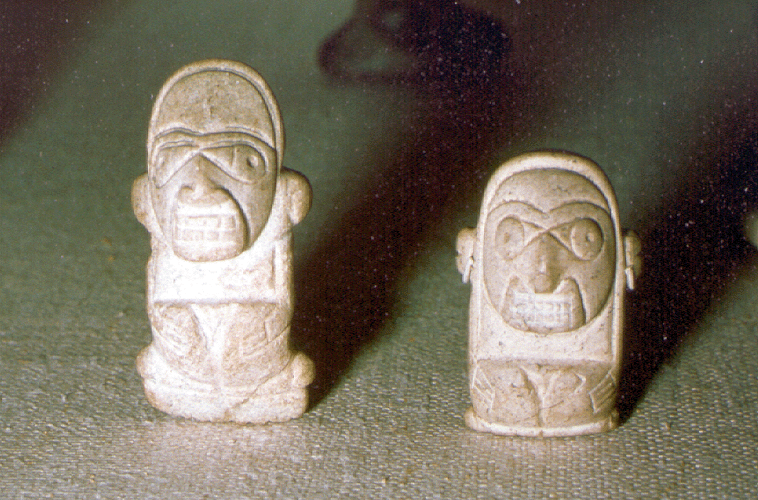 The art of the ta�nos, conceptual and at the same time, utility, reflects very soon, its magical-religious vision, of the world. Its works of art are represented by a vast domestic and personal use objects range, and, in individual, by a rich ceremonial repertoire. The variety and quantity of these objects, trabajosamente elaborate (we remember that not they arranged of metallic instruments) in the most most diverse material obtenibles in their environment or derived from their commerce, they constitute the sample more fehaciente of their innate artistic inclination.
The art of the ta�nos, conceptual and at the same time, utility, reflects very soon, its magical-religious vision, of the world. Its works of art are represented by a vast domestic and personal use objects range, and, in individual, by a rich ceremonial repertoire. The variety and quantity of these objects, trabajosamente elaborate (we remember that not they arranged of metallic instruments) in the most most diverse material obtenibles in their environment or derived from their commerce, they constitute the sample more fehaciente of their innate artistic inclination.The art ta�no achieves its more more beautiful plastic expressions in the medium one escult�rico. For the purpose of achieving their artistic objective, the ta�nos they utilized the hard stones as the granite, the diorita, the basalto and other easier tallar as the marble and the serpentina. In many cases the color of the stone, the vetas of the same one and the pulimento that achieved to give him facilitated and enriched the artistic work.
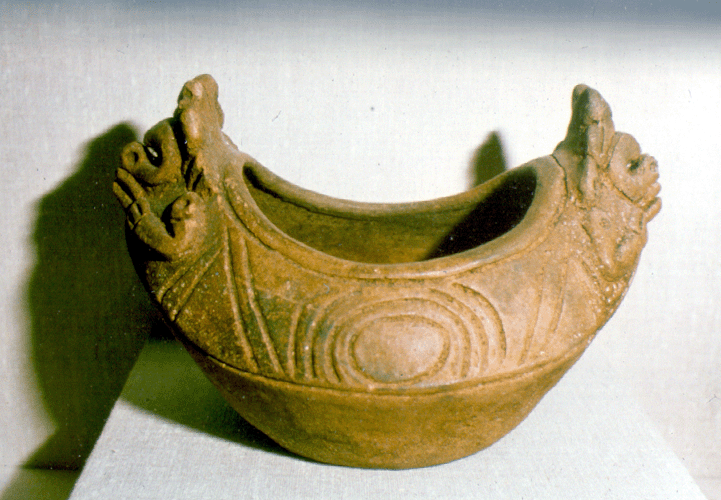
Exceptional also it is another figure tallada in bone that is conserved in the same Museum. It represents a torso male very well studied anatomical and with exaggerated male characteristics. The sculpture, although small -does not have more than fifteen centimeters of height- constitutes a great achievement therefore communicates the sensation of monumentalidad. These pieces talladas in bone are represented in correct proportions, which is not usual in the representations escult�ricas ta�nas.
They dominated ours Indian the art of the ceramics, in which they produced elaborate vasijas and platones, as well as corporal decorations and other objects utilities. The use of the clay permitted them, besides, modelar you figure antropomorfas and zoomorfas in which they did boasting of their artistic talent. In the Museum of the Dominican Man, and in the Museum of the Indian one American again York beautiful examples of the sculpture in clay are conserved of the ta�nos of The Spaniard..
Another important matter cousin that they directed that the artists ta�nos was the seashell of caracol, especially that of the Strombus, molusco that used like food and whose hard and beautiful white seashell served to elaborate infinity of small similar objects to the ones that worked in wood, bone and stone. They are emphasized in this production the of symbolic or magical-religious value, you elaborated by the most most dexterous makers for ceremonial uses and as corporal decoration. Among them the small they excel guaizas or masks that adorned the belts of the caciques and other ceremonial objects. Images of animals linked to its mythology as the rana, the dog, the fish and distinct classes of fowls, they were carefully tallados in seashell of caracol, medium that was also utilized for the talla of the small trigonolitos or idols of three tips .
The production of objects tallados in seashell of caracol has an extensive distribution in the Antillas Greater. Its pieces are example of the versatilidad of the artist ta�no, who estiliza and geometriza the human and animal figures that is used to representing to become true symbols or abstractions. Example of these estilizaciones of the human figure constitutes it a diminuto idolillo (that has lost the head) in the body of is represented in form tubular being emphasized only the arms, the ombligo and the legs. This idolillo, tallado in court of caracol, originates of the Dominican Republic and remains at present to the Collection of Hostos of the Museum of the University of Puerto Rico .
BACK
The native cotton, that the ta�nos they spinned and they wove with great dexterity, the matter cousin provided them to do the fabrics with which concocted the naguas, short aprons that were the only clothing of the married women. The cotton also facilitated them the weave of thick threads that, sewn some with other, permitted them to form figures of its God and spirits tutelares. The ta�nos, desconocedores of the art of melting the metals, they worked the pieces and grains of gold that collected in the rivers and streams with heavy hammers of stone to become thin leaves or laminas, the ones that utilized then in form desired .
Of these leaves or sheets of gold was that the makers ta�nos cut the pieces that then incrustaban in the dujos or ceremonial seats, the idols and other objects of the cultured magician-religious one. In all the Antillas Greater gold sheet fragments have been found that were used like corporal decorations or to adorn other objects. These sheets of gold were to engraved times or repujadas with chisels of stone. The columnists of the conquest inform us that the ta�nos also they made use of plants textiles as the maguey and of different classes of bejucos to have hammocks, baskets, decorations and other daily objects of use, but of great beauty. Thus also they utilized the beautiful feathers of multiple colors that the rich fauna provided them av�cola that then populated the different islands. The fountains etnohist�ricas describe us beautiful layers and done decorations of head of feathers of colors. Seeds as the of the palms of corozo and other also they were utilized like matter cousin to become corporal decorations.
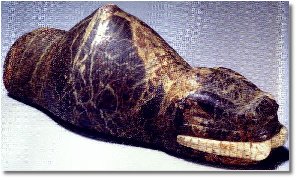
Unfortunately, the quick one desintegraci�n of the aboriginal society, the tropical climate so devastator for many of the materials utilized by the ta�nos to be expressed artistically; as well as the lack of interest of the colonizers to conserve these demonstrations of the aboriginal culture, has been responsible for that to us only a fraction of the representative objects of the art has arrived ta�no. By means of the �rescue� or exchange with the Indians of the Spaniard, of the tribute that imposed and of the incautaci�n of the goods of the rebels, privately the of the cacique Canoabo, Crist�bal Columbus gathered from among 1495 and 1496, a valuable treasure of objects permanecientes to the aborigines.
The inventory and the description of these objects obtained by Columbus offers us, of the culture ta�na, a new and extensive vision that neither the arqueolog�a not the chronicles could establish. Many of those objects, enriched with decorations of gold, they reveal the ceremonial wealth of the native society, as well as the precious multitude of objects that ours Indian they made use. In said Inventory (Happiness, 1980) is mentioned, for example �four perfumadores of noses with eleven you paint of gold�. These �perfumadores� not they were another thing that inhalaban the caciques and chamanes to enter communication with the God and spirits tutelares, after being prepared for the ceremony with long fasts and subsequent purifications. It is possible that the inhaladores described in the Inventory of Columbus they went of wood, similar al that was discovered in the Gonaive, Hait�, some years ago, and that is conserved in the Collection Maximilien, of that country. In the Antillas they have been found various, but none as rich as them obtained by Columbus .
BACK
In the archaeological investigations spatulas have been found v�micas, artistically talladas in bone of manat�, seashell of caracol and wood. In some cases the spatulas are decorated with incrustaciones of gold and of seashell of caracol. In the archaeological collection of the Foundation Garc�a Ar�valo of Holy Sunday, several spatulas are conserved v�micas of bone and wood with representations antropomorfas and zoomorfos, that al to seem they were enriched with incrustaciones of gold. In the Inventory of the objects that Columbus collected in the Spaniard in 1494 (Happiness, 1980) mention is done of �a purgadera with twenty and nine you paint of gold�. This spatula with incrustaciones of gold was part of the booty that it was taken al cacique Canoabo.
The spatulas v�micas of seashell of caracol are less abundant than the elaborate in bone of manat� since the material does not adapt very well to the requerimientos of length of the appliance. There is, however, an in the collection of the Museum of the University of Puerto Rico that by it singularly expressive deserves mention. It is a matter of a small spatula curve with a head humanoide that is projected lateral, representing a third part of the total length. The head is of form ovoide and its arches superciliares and cheeks form a species of framework al relief, inside which they figure, tallados in high relief, the eyes, sad and saltones, and an enormous nose aguile�a accentuates the expression of sadness. The fine mouth and closed -was not arranged of sufficient space represent in agreement with the traditional form- occupies the lower third of the face, that representing ites in a sharp one barbilla.
The better demonstrations of the sculpture taina are the idols of the cojoba. These they represent you figure antropomorfas male, generally acuclilladas, in Io that seems to be a ceremonial position. Upon the head, directly or maintained by a piece of wood that the spine of the idol came out of, figure a plate to circulate, slightly concave, in which placed the dust alucin�geno that aspired the oficiante of the ceremony. A beautiful copy of Jamaica, tallado in guayac�n, conserved in the British Museum, maintains still its brilliant one pulimento. This idol of the cojoba shows to side and side of the face, under the Eyes, some deep vertical incisions, interpreted like tears, that they associate it with the rain. The Smithsonian Institute of Washington, D.C. preserve one of these idols in which two human figures appear acuclilladas upon a dujo, with the plat�n ceremonial maintained upon their heads by a vertical piece. The figures seem to represent a clear allusion to the twins, fear of the mythology ta�na. lncrustaciones of gold or some another material they should have enriched the eyes and the mouth of the figures. In the primitive collection of art of the Metropolitan Museum of New York is hoarded a magnifico idol tallado in guayac�n that responds to the carac- ter�sticas always present in the other idols of the cojoba. The male figure still retains its dentadura tallada in seashell of caracol .
This piece is a good example of the creatividad and ingenuity of the artist taino of late epoch; true teacher in harmonizing the diverse materials, technical, motives and designs of which was worth itself, without losing never the sense of unit of the piece. The idol consists of the talla in wood of a bust bic�falo, with faces in opposite sides. Covering all except the faces, a weave of cotton decorated with changes you count in seashell of caracol of delicate tones of madreperia and black, complicated designs Geom�tricos. In the conventional figures of cheurones. In one of the faces, its expressive eyes are represented by incrustaciones of seashell of caracol, while in the other, al the same as in the decorations of both ears, a disk of a novel material has been used -rock it- imported by the Spanish colonizers, locates the piece in historic times, Al to speak of the use of the weave as complement of the tallas in wood not to can stop referring us to the only sculpture ta�na existing totally elaborate in weave of cotton. We refer to an exceptional piece conserved in the Museum of Turin, Italy, that in the impossibility of obtaining in loan for this exposition, they have illustrated through photographs. Weave with a technique seemed al macram�, the male figure conserves in the interior of the head a human skull, possibly that of a cham�n or cacique. The columnist Du Tertre relates the impression of fear of the caribes of Martinica before the find of an idol seemed:.
�... Some idols of cotton with form of men that had grains of jaboncillo instead of eyes and a done species of helmet of cotton upon the head, they assure that was the God of the igneris that they there were masacrado, neither a single savage dared to enter this cavern and they trembled from fear when they approached her "..
The cem�s or idols trigonol�ticos of various types iconogr�ficamente reconocibles, are the pieces escult�ricas more more abundant and interesting of their parafernalia magical-religious. By their basic form, the argue�logos they have identified them with mountains, with the yuca germinating, with the chests of the woman and with God or upper spirits. Although in the Antillas Smaller and still in the coast caribe�a of Colombia have been discovered small trigonolitos simple, the center of their distribution is located in Puerto Rico and the region this of the Dominican Republic..
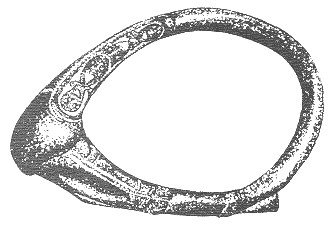 The cem�s trigonol�ticos they have three fundamental parts: the previous projection, the central cone and the subsequent projection. The central cone, lightly inclined toward the front, defines you split them when the cem� is simple, without any talla. The base of the idol is, by Io general, slightly concave, Io that have done to believe to some studious that was adhered to other objects of wood or stones.
The cem�s escult�ricos they represent you figure antropomorfas, zoomorfas or antropozoomorfas. The head, humanoide or zoomorfa, this almost always tallada in the previous projection, front al central cone, while in the subsequent cone the lower extremities appear, generally in form of ancas of rana. They are possible representations of figures ancestrales, tot�micas, mythological, or symbols of powerful natural strengths. The heads occupy all the previous projection and frequently they are crowned with a diadema or ban- gives decorative that finishes, in both sides of the head, in large orejeras. The face, that follows the form of the previous projection, covering it completely, exhibits for eyes, depressions you circulate or ovoides. The nose, that dominates the center of the face and part since the eyebrows or arches superciliares, is more or less triangular and is projected toward the front. The mouth, concavity ovoide or semicircular, is large and noticeable. Neither the textura of the interior of the basins of the eyes neither that of the interior of the mouth itself pul�an as the surface of the idol in order to filling them with incrustaciones of sheets of gold or of seashell of caracol, adhered with resins. In the archaeological excavations they are used to finding pieces of seashell of caracol with incisions that they represent dentaduras. lndudablemente is a matter of incrustaciones removed of idols of wood and stone. In the Museum of the University of Puerto Rico is conserved a cem� trigonol�tico that represents a reptil. Its enormous one dentadura of seashell of caracol still remains adhered to the mouth of the idol..
The cem�s trigonol�ticos they have three fundamental parts: the previous projection, the central cone and the subsequent projection. The central cone, lightly inclined toward the front, defines you split them when the cem� is simple, without any talla. The base of the idol is, by Io general, slightly concave, Io that have done to believe to some studious that was adhered to other objects of wood or stones.
The cem�s escult�ricos they represent you figure antropomorfas, zoomorfas or antropozoomorfas. The head, humanoide or zoomorfa, this almost always tallada in the previous projection, front al central cone, while in the subsequent cone the lower extremities appear, generally in form of ancas of rana. They are possible representations of figures ancestrales, tot�micas, mythological, or symbols of powerful natural strengths. The heads occupy all the previous projection and frequently they are crowned with a diadema or ban- gives decorative that finishes, in both sides of the head, in large orejeras. The face, that follows the form of the previous projection, covering it completely, exhibits for eyes, depressions you circulate or ovoides. The nose, that dominates the center of the face and part since the eyebrows or arches superciliares, is more or less triangular and is projected toward the front. The mouth, concavity ovoide or semicircular, is large and noticeable. Neither the textura of the interior of the basins of the eyes neither that of the interior of the mouth itself pul�an as the surface of the idol in order to filling them with incrustaciones of sheets of gold or of seashell of caracol, adhered with resins. In the archaeological excavations they are used to finding pieces of seashell of caracol with incisions that they represent dentaduras. lndudablemente is a matter of incrustaciones removed of idols of wood and stone. In the Museum of the University of Puerto Rico is conserved a cem� trigonol�tico that represents a reptil. Its enormous one dentadura of seashell of caracol still remains adhered to the mouth of the idol..BACK
Another type exists of cem� trigonol�tico, more collected and small, in whose central cone the head is represented, generally humanoide. Al spine of the effective, central cone achieved by means of deep incisions, the ribs are represented, v�rtebras and extremities, these last generally shrunk, as the of the ranas, besides a decoration of motives geom�tricos clauses of doubtless symbolic value..
In another type of representation, the idol of three tips exhibits the central cone become expensive human or animal, with the nose or snout represented in the apex. In this type they are given various exemplary bic�falos. One of them it represents a rana, very well tallada, with the body and head in the central cone and the lower extremities in the subsequent one. The rana maintains, in its strong forward extremities, a human head tallada in the previous projection. Another type very seemed, with the central cone become human head, shows also another human head in the previous projection. Both idols belong al Museum of the University of Puerto Rico. In Puerto Rico they are rare the cem�s trigonol�ticos with representations of arms. A beautiful copy of the Collection exists Of Hostos in the Museum of the University, of possible Dominican origin, with arms clauses that they are projected since the sides of the central cone to the front. It is possible that the elaborate decoration incisa in the body have been fills with pigmento white or red, forming a gaudy contrast with the surface, darker, of the stone. In the region this of the Dominican Republic they are abundant the trigonol�ticos with representations of arms and other designs clauses .
Another important expression escult�rica of the ta�nos they are the Ilamadas masks antropomorfas of stone, with traditional characteristics of large and expressive eyes and open mouth in rictus ceremonial. These masks talladas in a n�dulo of stones are of form ovoide and with it splits subsequent slightly convex and without pulimento, Io that induces to think that they went adhered to other materials. The existence of small figuritas with similar masks tied to the forearms have done to think to Happiness (1986) that these pieces were part of the parafernalia of the players of the ceremonial play of ball of the tainos. These mascaras in their original state apparently they should show incrustaciones in the eyes and the mouth .
The large and well pulimentadas heads antropomorfas, as the very acquaintance of the Collection Of Hostos, originating from Macor�s, in the Dominican Republic, and conserved in the Museum of the University of Puerto Rico, they constitute excellent copies in stone of the sculpture taina. These heads, of great size, that they rest upon a thin neck -which apparently, is a vestigio of the proyecci6n subsequent of the trigonol�to- they show the previous projection in form of cap or decoration upon the head. As these pieces they originate of collections and not of archaeological excavations, cannot be determined if the same represent a late evolution of the form ancestral of the trigonolito. In these, as in other idols of stone and wood, the lack of pulimento in the basins of the eyes and in the mouth indicates us that they should have incrustaciones of gold and seashell of caracol .
Some of these heads that they have been you considered like a modality of the cem� or trigonolito, they represent human skulls. Associated al batey or play of ball of the ta�nos of the Antillas Greater, that was celebrated in stock as that of Caguana, Puerto Rico or the of the Dominican Republic, they appear some of the most most exceptional pieces of the sculpture taina -the belts monol�ticos previously called "necklaces of stone" and the calls "elbows". The belts monol�ticos respond to three types: thin, intermediate and thick. The most most elaborate and ornamentados are the thin that consist of a simple section tubular with ensanchamiento or back toward an extreme. To the sides of this back there are two paneles, one of which shows to times tallas of figures antropomorfas or zoomorfas, skillfully desarticuladas to adapt them to the small paneles decorative of the piece. The other panel almost always has a depression ovoide without pulir that has been interpreted servia to adhere to 61 some another object.
The calls "elbows of stone" went also, undoubtedly, associated belts al I play of ball but that, contraryly to the monol�ticos, they were adhered to an arch of wood or straw that completed the belt. The most most elaborate they show expensive human talladas to a side of the ensanchamiento, while in its extremes they exhibit ranuras or drillings in which was tied that of elbow" of stone al arch of wood or weave of fibers to form the belt. Some examples exist as the conserved in the Museum of I Loved- rich in Madrid in which besides the expensive human the figure is presented esquematizada of a human body characterized by its lack of proportions .
One of the but beautiful belts monol�ticos of Puerto Rico, today in the Museum of the American Indian of New York, sample a head antropomorfa with two large orejeras talladas in the panel central .
BACK
The "elbows" as well as the belts monol�ticos, that by long time they went respected enigmatic objects, they stir up the most most various inter- pretaciones. Today, the studious most authorized accept that, al the same as the "yugos" of the totonacos of Mexico, they constitute ceremonial belts that formed part of the parafernalia of the play of ball. It is possible that their use had been discontinued before the arrival of the Europeans and by this reason is not described them in the chronicles of the Conquest. .
The talla of these belts monol�ticos, especially the thinnest, constitutes the best demonstration of the control reached by the ta�nos in the technique of tallar and pulir stones of great hardness. To be able tallar these aros l�ticos, so thin -to times with a diameter of only 3.5 centimeters- making use of rough tools of stone, without them to break those, is a true boasting of technique that does not have parallel in no other aboriginal culture of America.
The dujos or ceremonial seats, tallados in wood or in stone, they constitute another important modality escult�rica of the tainos. The columnists of lndias indicate that these dujos they constituted one of the more preciados treasures of the Indians. The same they were used for the caciques, chamanes and visiting distinguished during the ceremony of the cohoba, in the areytos and play of ball and to bury, acuclillados upon them, to the caciques.
The dujos zoomorfos, of possible signified tot�mico and mythical, they show the head of the animal excelling from among the two forward legs, while the narrow seat, slightly concave, extends and raises to form the espaldar, simulating the queue of the mythical animal. From time to time, its expressive eyes and the mouth were realzados artistically by means of incrustaciones of lamina of gold, seashell of caracol or resins. In the most most beautiful discovered example in the Dominican Republic and today conserved in the British Museum, fine sheets of gold ornamentan the eyes, the mouth and splits it dorsal of the forward legs. In some cases the espaldar and the legs are decorated with designs clauses, integrated by circles conc�ntricos, triangles and cheurones .
Of the Museum of the Dominican Man is an exceptional one dujo of s�lida tropical wood beautifully veteada. The seat is oval backwards and straight al front, where projects an expensive one antropozoomorfa. It splits it upper of the same one considers deep eyes basins and some orejeras with decoration incisa; in it splits lower, the nose and an extensive mouth are integrated in the face to form a species of snout. The piece is cu�druple and their previous legs, doubled in straight angle to side and side of head, they are decorated with elaborate designs clauses. The dujos also they were done in form of small banks of four legs whose only decoration were designs geom�tricos clauses in the legs and in the seat .
The talla escult�rica is also manifested in the ceremonial containers of use that of the tropical woods they did the ta�nos. In the Dominican Republic and in Puerto Rico have been discovered, hidden in the cracks of caves and other refuge p�treos, small pots and trays carefully talladas, that apparently were utilized to hoard decorations and other ceremonial objects of use. The collection of the Institute of Puerto Rican Culture possesses one of them, a vasija efigie, in which splits it to circulate of the container represents the body of the figure and the extremes you split them upper and lower of the same one. In the Museum of the University of Puerto Rico is conserved another of these small vasijas of wood of guayacan, whose diameter does not surpass the twelve centimeters, with you roast, in human form of heads, to each extreme. The upper edge this ornamentado with designs clauses. This ollita went discovered among the cracks of a rocky hill of Quebradillas being found inside the same numerous accounts tubulares of granite, of them utilized by the tai- us in their necklaces, mixed with accounts of crystal veneciano, of the ones that the conquering Spaniards gave to the Indians. Also it contained eyeteeth of dogs perforated to use as hanging and a small gold sheet decoration repujado. In the Museum Etnogr�fico of Florencia a beautiful oval tray is conserved that in one of its extremes shows a small one figurita antropomorfa that still exhibits a diminuta dentadura of seashell of caracol. In the Dominican Republic have been discovered ollitas of wood, similar to the of Puerto Rico .
In the archaeological collections of the Dominican Republic they abound the majadores tallados in stone with representations antropomorfas or zoomorfas. These majadores they constitute one of the most most interesting expressions of the art escult�rico ta�no. Another important artistic expression of the tainos, that ourselves consider associated al art of the sculpture, they are the petroglifos, or engravings in the stones. In the Antillas Greater, especially in Puerto Rico and The Spaniard, the ta�nos they left its petroglifos in the monolitos that they delimit the plazas or bateyes for the play of ball, in the large stones in the river bed of the rfos and streams, in the walls of the caverns and in stones isolated in places where apparently some sacred fact occurred..
BACK
The theme of the Petroglifos is the human or animal figure very esquematizada. Also themselves tallan heads antropomorfas and of mythical beings of the ones that cannot be needed if they have forms human or of animals. Designs geom�tricos as Greeks and other abstract, which figure in the walls of the Cave of the Indian, in Arecibo, they are also current in the assemblies of petroglifos that they left us the ta�nos of the Antillas. The main assembly is that of the plaza cuadrangular of the Ceremonial Center of Caguagana, Utuado, in the mountainous interior of Puerto Rico. In the row oeste that limits said plaza and among some petroglifos of distinct sizes and you fear, they exceed him the figure esquematizada of a woman whose head shows a radial decoration finished in two enormous orejeras circulates. Next to this image of woman, and in other monolitos there is petroglifos that they represent the male figure very esquematizada. Another of the petroglifos of the plaza of Caguana shows the silhouette of a great fowl, possibly an alcatraz .
Some petroglifos they have been tallados in monolitos whose natural form has been utilized for the representation of the figure, that as in the case of one of Puerto Rico, belonging to the Collection Latimer and that is conserved in the Smithsonian Institute of Washington, D.C., covers two thirds of the stone. Have been discovered test that some petroglifos were backfill with pigmentos white or red, that they did them to be emphasized of the darkest surface of the stone. In the Ceremonial Plaza of Utuado there are some heads antropomorfas with so deep eyes that they induce us to believe were backfill with incrustaciones of other materials. The etno-historic fountains also speak us of other objects of interest escult�rico, that desafortunadamente not there they are Ilegado to us. Among them they figure the propellants of darts tallados in wood and enriched with incrustaciones of gold; elaborate canes of command tallados in the hard tropical woods; mascaras ceremonial of wood with incrustaciones of other materials; idols, possibly of wood, covered with I�mina of gold; trompetas skillfully talladas with symbolic designs and, finally, the canoes of the caciques, whose rich and elaborate decoration called the attention of the conquering Spaniards. Unfortunately, the quick one desintegraci�n of the aboriginal society, the nature perecedera -m�xime in a tropical climate as ours- of many of the materials utilized by the tainos to be expressed artistically, as well as the lack of interest of the colonizers to conserve the demonstrations of the aboriginal culture, have been causes that to us only a small fraction of the representative objects of the art has arrived taino .
This tight synthesis of the main expressions escult�ricas of the ta�nos of the Antillas Greater, only permits us to have a vision limited of the art escult�rico of the old settlers of our islands. Future archaeological investigations continued enriching with their finds the collections antillanas that today hoard this inheritance..
(MELA PONS ALEGRIA, RICARDO E. ALEGRIA. San Juan of Puerto Rico. 15 of May of 1987) Taken of:.
EXPOSITION OF SCULPTURES OF THE Indian TAINOS.
CENTER OF STUDIES ADVANCED OF Puerto Rico AND THE CARIBE MAY 1987 SAN JUAN P.R..
Composition: Novograph.
Impression: Publishing Corripio C. by A. Printed in Republic Dominican
Ricardo Happiness Copyright � 1987. All the rights reserved.
BACK
Book: The Indians of Boriqu�n 1990
Autora: Wilma J. Oak trees, Ph.. D.
Productions Anisa, Good Water, P, R.
Job investigativo: Origin and Inheritance Taina 2001
Author: Carlos L. Camacho
BIBLIOGRAF�A FOR THE STUDY OF THE SCULPTURE TAINA
FOUNTAINS ETNO-HISTORICAS
Angler�a, Pedro Martir of 1965 Decades of the New World. Jos� Porr�a and children. Mexico- (2 vols.)
You marry, Bartolom� of the 1909 Apologetic History of the Indias, Madrid.
1957 History of the Indias, Spanish Library of Authors. Madrid. Chanca, Diego Alvarez 1858 "This it is, the First Trip and the routs and road that did the Admiral D. Crist�bal Columbus..." in Collection of the Trips and discoveries... Published by Mart�n Fern�ndez of Navarrete, I, Madrid.
1858 "Second Trip of Crist�bal Columbus" :, in Collection of the Trips and Discoveries. Published by Mart�n Fern�ndez of Navarrete. Vol. I, Madrid.
Pichardo Moy.
Book: The Indians of Boriqu�n 1990
Autora: Wilma J. Oak trees, Ph.. D.
Productions Anisa, Good Water, P, R.
Job investigativo: Origin and Inheritance Taina 2001.
Author: Carlos L. Camacho
instruments taino.
1. guiro.
2. maracas.
3. drum.
4. pito or fotuto
plates tainos.
1. arepas.
2. married.
3. guanime.
SPANISH VERSION TAINA
MARCH 18, 2002
Feb 28, 2010 UPDATE
REFERENCE LINKS:
HOME
HERENCIA TAINA
ESCULTURA TAINA
FOTOS TAINA
CULTURA TAINA
BANEQUE
MY FAVORITE LINKS:
HOME
TRANSLATOR
EMAIL
POSTAL
NEWS
DOWNLOAD
ANIMAL EXTINT
PUERTO RICO
MAJAGUANY POLICY
BOX 6243 STATION#1
BAYAMON,P,R.00961
TEL.(787)423-6006
(787)423-6020
CEL.(787)404-4114

